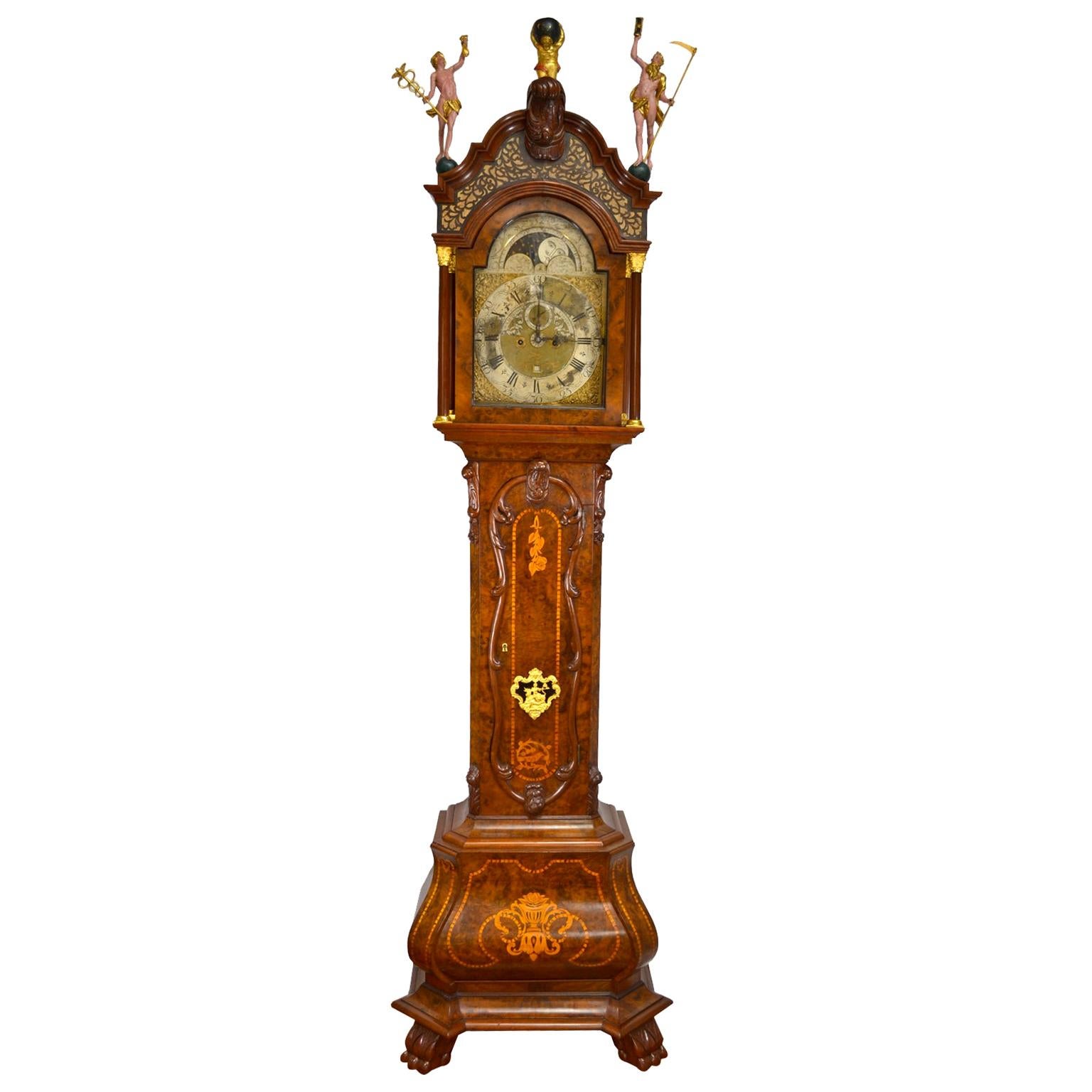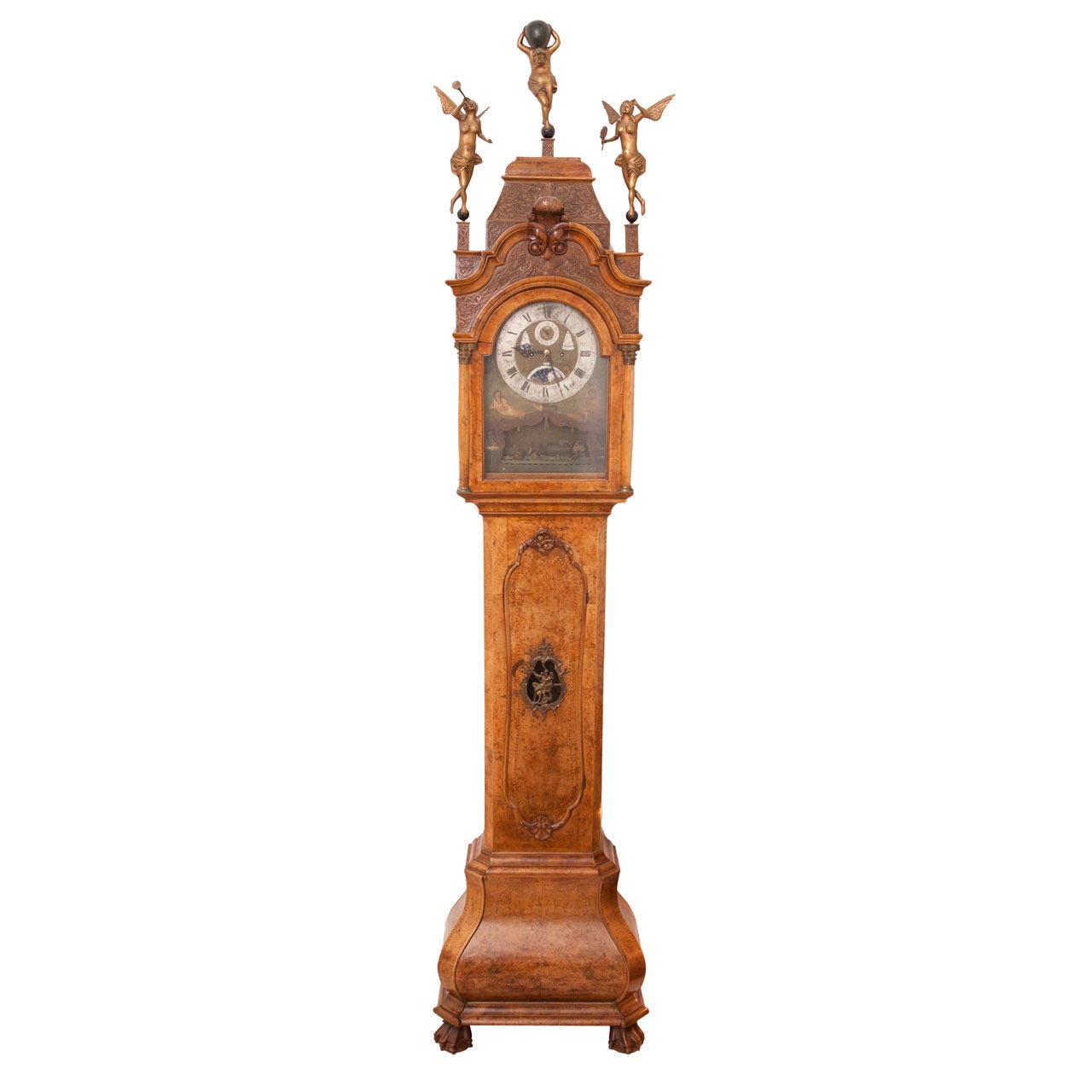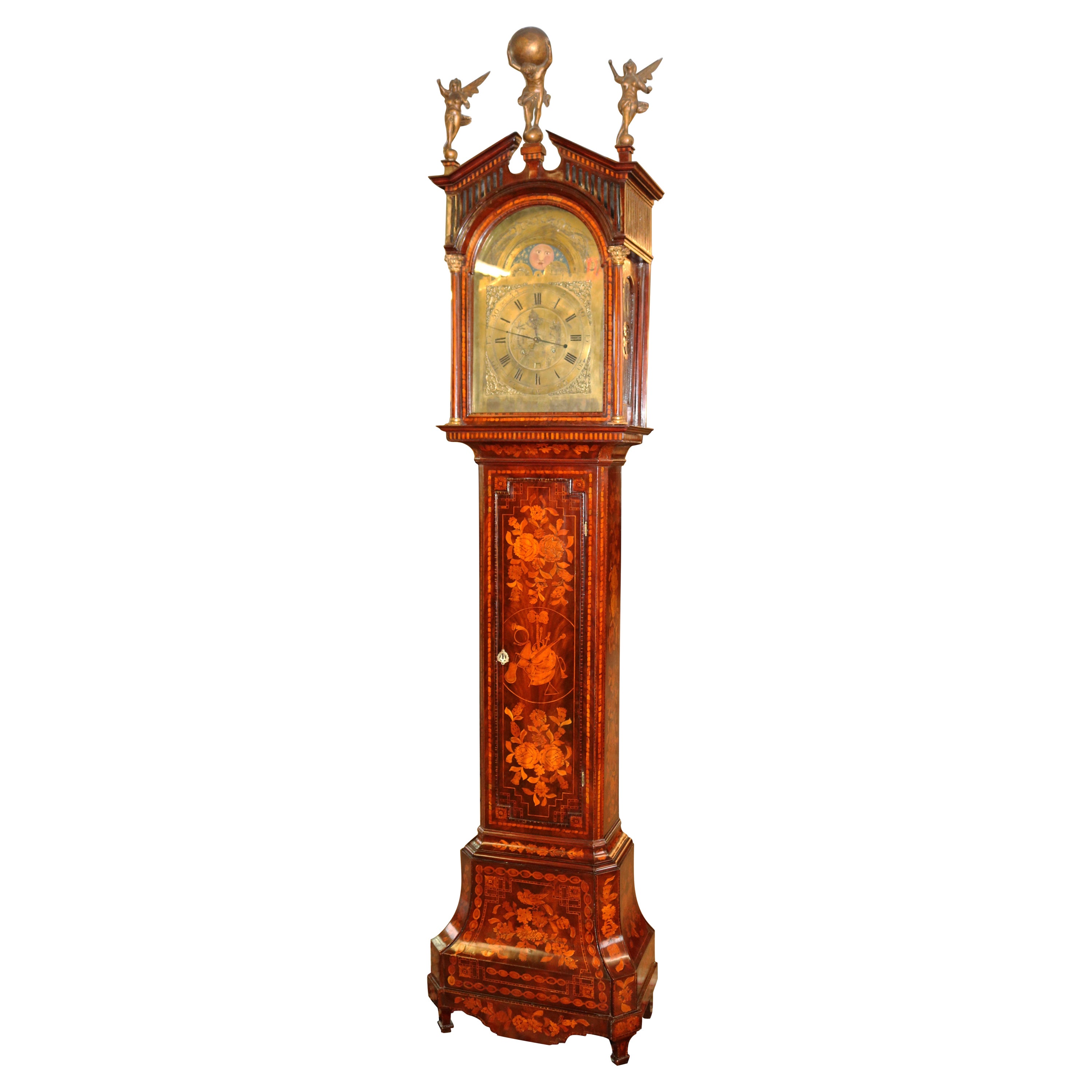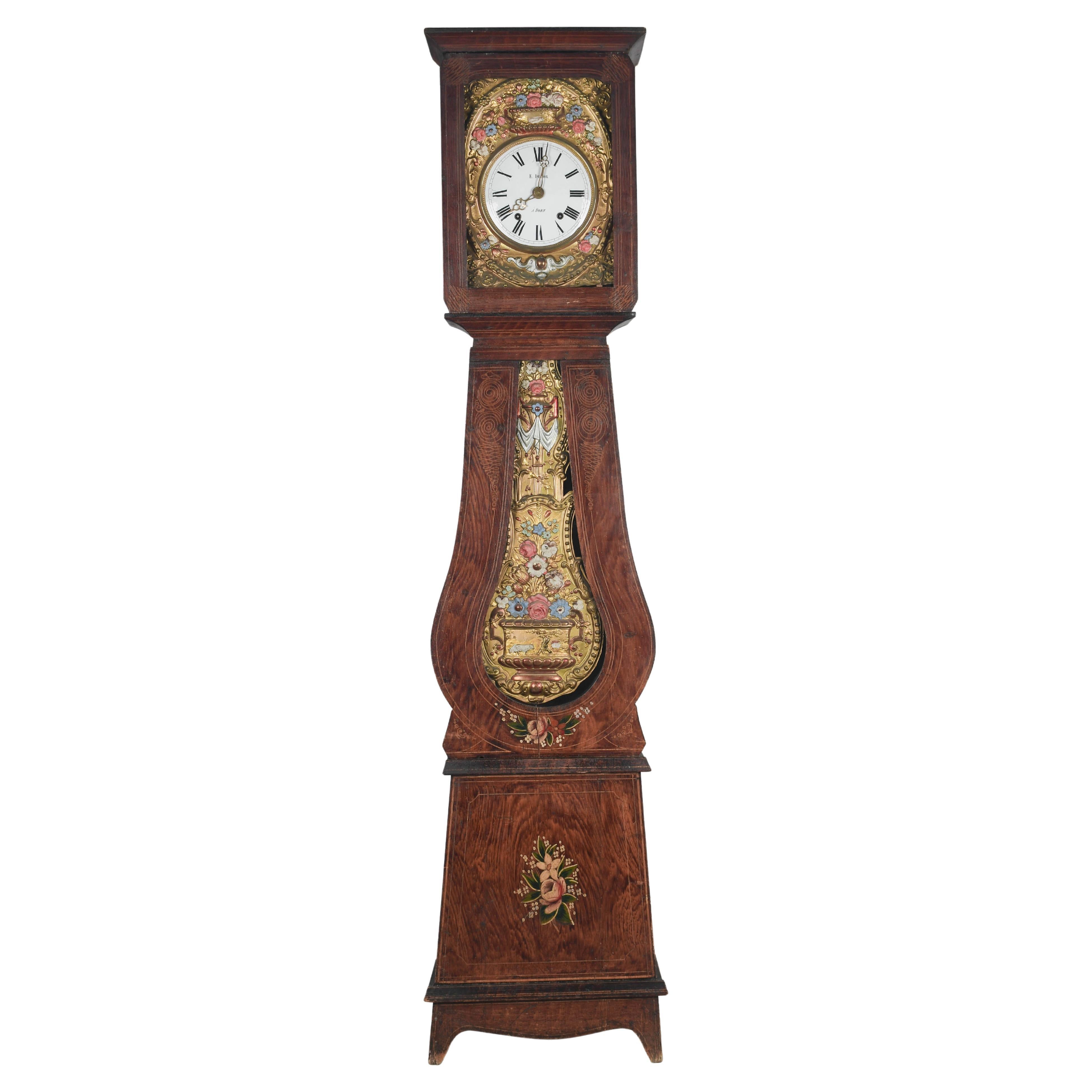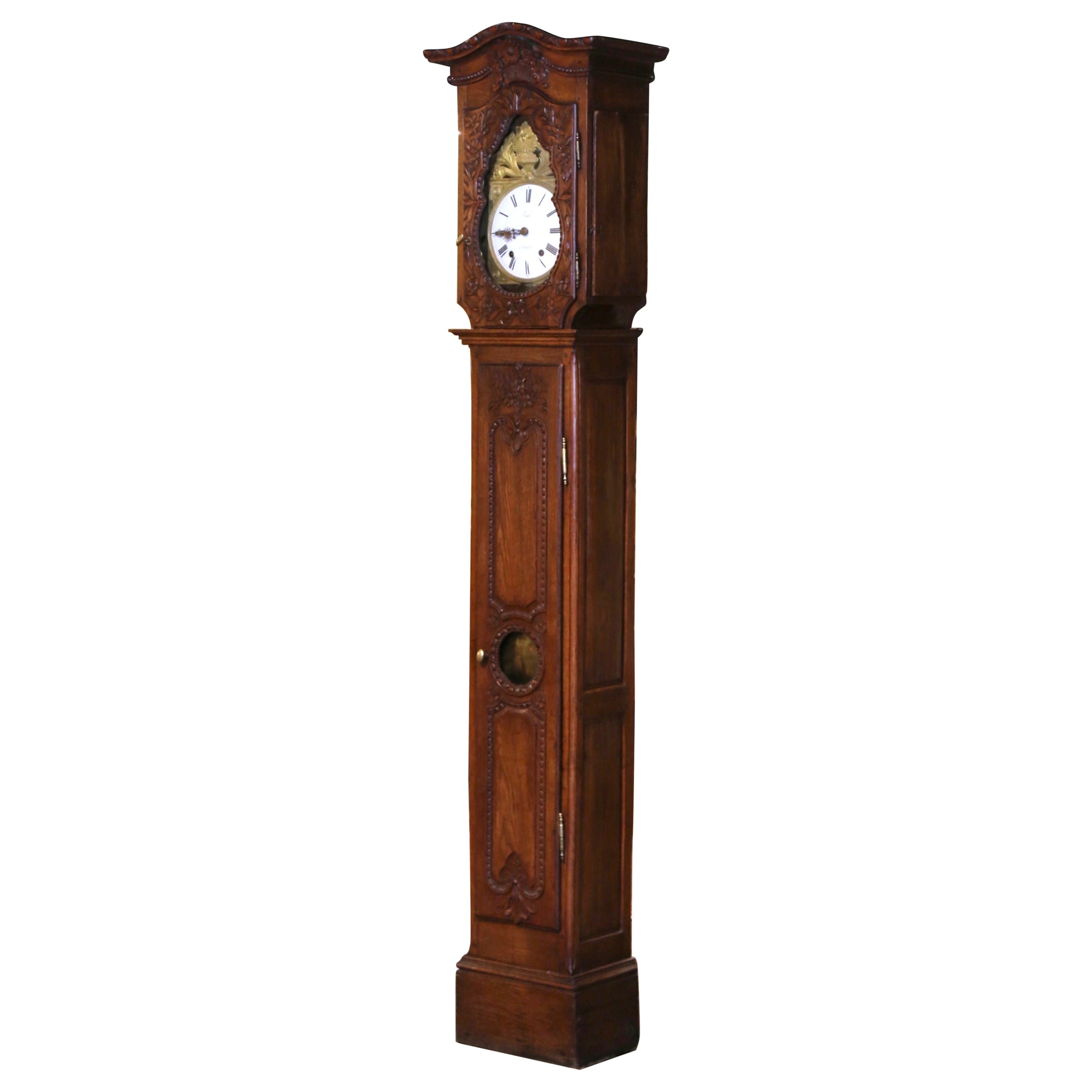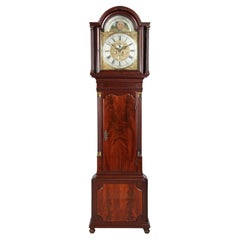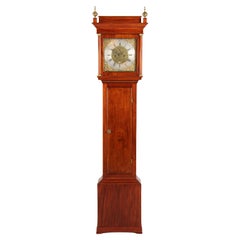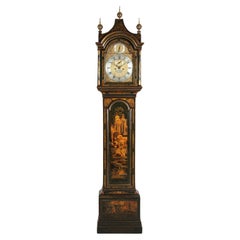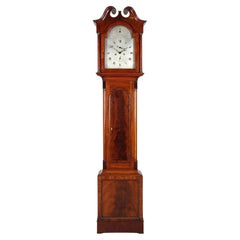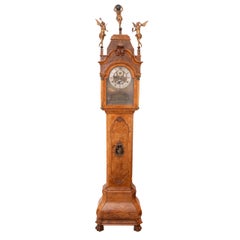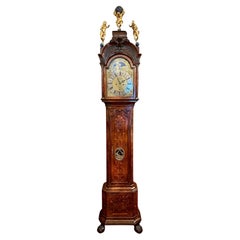Artículos similares a 18th Century Dutch Grandfather Clock, Calendar and Moonphases, Amsterdam 1760-70
Cargando vídeo
¿Quieres más imágenes o vídeos?
Solicita imágenes o vídeos adicionales al vendedor
1 de 21
18th Century Dutch Grandfather Clock, Calendar and Moonphases, Amsterdam 1760-70
15.500 €IVA incluido
Acerca del artículo
Antique Amsterdam grandfather clock with alarm, calendar and moon phase
Amsterdam
Walnut root and others
circa 1760
Dimensions:
H x W x D: 283 x 58 x 30 cm - without figures the height is reduced to 241 cm
Description:
Elaborate grandfather clock in typical Amsterdam design with figure crowning.
The walnut-root veneered body with fine maple inlays stands on so-called ball-and-claw feet, which were particularly popular in the mid-18th century. The lower part of the body is, also typical of the time, strongly bulging, while the centre part is recessed in width and has a curved door at the top and bottom with thread inlays following this line. The asymmetrical, ormolu framing of the viewing window with its C-curves, flowers and rocailles corresponds to the formal language of the Rococo period.
The head of the clock is spectacular. The round arch supported by four columns with openwork above is complemented by a pedestal-like structure with carved and oil-gilt figures. On the left we see Hermes, the messenger of the gods, here as the patron saint of trade with a quill and purse; and on the right Fama, the goddess of fame with the Roman tuba in her hand. And enthroned above all this is Atlas, the Titan, holding the celestial globe.
A very similar case, with a clockwork by Otto van Meurs, is described in Jan Zeeman - De Nederlandse Staande Klok on pages 126-128. (See photo) It reads as follows:
Otto van Meurs had a particularly skilful case maker, distinguished by his refined workmanship and the beautiful colour of the walnut veneer. The inlay work on the double-curved base of the clock dates from this period. The moulded part on the pendulum window clearly shows that an elegant and playful interplay of lines was a basic requirement at this time.
It is obvious that the case of the clock on offer here comes from the workshop of this very case maker.
The dial is also particularly interesting. The moon phase and the age of the moon can be seen at the top of the arch. The fact that the moon is firmly mounted and the celestial disc rotates in front of it is unusual and therefore particularly noteworthy. This is a rare design which, in contrast to the usual rotating moon, still leaves space to the left and right of the arch. This space was used for a fine painting:
Against the expanse of the sky and in the shade of the trees, we see on the left hand side Spes, the personification of hope, leaning on an anchor and ensuring a good harvest; and on the right, Caritas as the personification of charity, here mercifully caring for the family.
Below this is a silver-plated chapter ring with black Roman numerals for the hours and Arabic numerals for the minutes, which are rotated from 20-40, typical of the time and region. The finely sawn and blued steel hands run in front of a small silver ring, which is used to set the alarm time.
Below this, we see the day of the week in a triangular window with the corresponding Greek symbol and a personification of a deity, in this case Chronos, who stands for Saturday and who limits life with his scythe. The other days of the week are symbolised by Diana, the goddess of the hunt on Monday; Ares, the god of war and battle on Tuesday; Hermes, the messenger of the gods on Wednesday; Zeus, the highest of all gods on Thursday; Venus, the goddess of love and beauty on Friday; and Apollo, the god of music and beautiful things on Sunday.
Above the winding holes we see a small sub-dial for the seconds, a window for the date and the signature of the master clockmaker - Jan Storm - Amsterdam.
The Storm family is recorded with several generations of clockmakers in Amsterdam from 1672. According to Enrico Morpurgo - Nederlandse klokken- en horlogemakers vanaf 1300, Jan Storm was active from 1717. The clock offered here probably dates from the last years of his workshop.
The weight-driven movement, with a power reserve of one week, strikes the number of hours on the half-hour and hour, and a single strike for each quarter hour.
Condition:
Very good, restored condition of movement and case. The movement has been completely dismantled, cleaned and overhauled, the case has been primed with shellac and matted with wax.
The top pedestal of the head was not present at the time of purchase and was added during the restoration according to the old model. On the photo showing the back wall of the case, you can see that the back wall was first shortened and then lengthened again, presumably for transport during a move.
We recommend the following literature for this clock:
Jan Zeeman - De Nederlandse Staande Klok
You can find out more about the creative period of the Storm clockmaking family in the following directory:
Enrico Morpurgo - Nederlandse klokken- en horlogemakers vanaf 1300
- Dimensiones:Altura: 283 cm (111,42 in)Anchura: 58 cm (22,84 in)Profundidad: 30 cm (11,82 in)
- Estilo:Luis XV (Del período)
- Materiales y técnicas:
- Lugar de origen:
- Época:1760-1769
- Fecha de fabricación:1760-1770
- Estado:Sustituciones realizadas: The top pedestal of the head was not present at the time of purchase and was added during the restoration according to the old model. On the photo showing the back wall of the case, you can see that the back wall was first shortened and then lengthen. Desgaste acorde con la edad y el uso. Very good, restored condition of movement and case. The movement has been completely dismantled, cleaned and overhauled, the case has been primed with shellac and matted with wax.
- Ubicación del vendedor:Greven, DE
- Número de referencia:1stDibs: LU5419245432442
Sobre el vendedor
4,9
Vendedor Platino
Vendedores premium con una calificación de +4,7 y tiempos de respuesta de 24 horas
Establecido en 2014
Vendedor de 1stDibs desde 2020
197 ventas en 1stDibs
Tiempo de respuesta usual: 1 hora
- EnvíoRecuperando presupuesto…Envío desde: Münster, Alemania
- Política de devolución
Partes de esta página se han traducido automáticamente. 1stDibs no puede garantizar la exactitud de las traducciones. El inglés es el idioma predeterminado de este sitio web.
Garantía de autenticidad
En el improbable caso de que haya algún problema con la autenticidad de un artículo, ponte en contacto con nosotros en un plazo de 1 año para recibir un reembolso total. DetallesGarantía de devolución de dinero
Si tu artículo no es como se describe, sufre daños durante el transporte o no llega, ponte en contacto con nosotros en un plazo de 7 días para recibir un reembolso total. DetallesCancelación dentro de las 24 horas
Tienes un período de gracia de 24 horas para reconsiderar tu compra, sin preguntas.Vendedores profesionales aprobados
Nuestros vendedores de primera clase deben cumplir estrictos estándares de servicio para mantener la integridad de nuestros anuncios.Garantía de igualación de precios
Si encuentras que un vendedor publicó el mismo artículo por un precio menor en otro lado, igualaremos ese precio.Entrega global de confianza
Nuestra red de transporte de primera ofrece opciones de envío especializado en todo el mundo, que incluye envío personalizado.Más de este vendedor
Ver todoReloj inglés de caja larga con fases lunares de finales del siglo XVIII, Manchester, hacia 1780
Reloj de pie inglés de finales del siglo XVIII con fases lunares
Inglaterra (Manchester)
Caoba
segunda mitad del siglo xviii
Dimensiones: Alto x Ancho x Fondo: 209 x 56 x 25 cm
De...
Categoría
Antiguo, finales del siglo XVIII, Inglés, Relojes de pie y relojes de ca...
Materiales
Caoba
Reloj de pie inglés del siglo XVIII de James Pike
Antiguo reloj de pie Jorge III de Newton Abbot
Inglaterra (Newton Abbot)
Caoba
hacia 1790
Dimensiones: Alto x Ancho x Fondo: 207 x 50 x 27 cm
Descripción:
Un estuche de madera de ...
Categoría
Antiguo, finales del siglo XVIII, Británico, Relojes de pie y relojes de...
Materiales
Latón
Reloj de pie Chinoiserie, Inglaterra, Londres, Mediados del siglo XVIII, Reloj de caja larga
Por James Scholefield
Reloj de pie Chinoiserie
Inglaterra (Londres)
roble pintado
mediados del siglo xviii
Dimensiones: Alto × Ancho × Fondo: 236 × 48 × 24 cm
Descripción:
Antiguo reloj inglés de caja ...
Categoría
Antiguo, mediados del siglo XVIII, Británico, Chinoiserie, Relojes de pi...
Materiales
Roble
Reloj escocés de caja larga fabricado por William Spark, Aberdeen, hacia 1820
Reloj de pie Jorge III con esfera plateada
Escocia (Aberdeen)
Caoba
Jorge III hacia 1820
Dimensiones: Alto x Ancho x Fondo: 222 x 47 x 23 cm
Descripción:
Precioso reloj de pie esc...
Categoría
Antiguo, Década de 1820, Escocés, Jorge III, Relojes de pie y relojes de...
Materiales
Caoba
Reloj de pie inglés de mediados del siglo XIX con esfera redonda pintada
Antiguo reloj de pie inglés con esfera pintada en caja de caoba
La caja se apoya en pequeños pies redondos y tiene una amplia sección inferior, sobre la que hay una sección más estr...
Categoría
Antiguo, Mediados del siglo XIX, Británico, Relojes de pie y relojes de ...
Materiales
Caoba
Reloj de chimenea del siglo XIX "Astronomía", Francia hacia 1830
Reloj de chimenea antiguo sobre el tema de la astronomía
Francia
Bronce
Charles X hacia 1830
Dimensiones: Alto x Ancho x Fondo: 48 x 19 x 10 cm
Descripción:
Inusual y bellamente e...
Categoría
Antiguo, siglo XIX, Francés, Carlos X, Relojes de mesa y relojes de escr...
Materiales
Bronce
También te puede gustar
Reloj de caja larga o de pie holandés del siglo XVIII "Utrecht" de W.V. Dadelbeek
Por W.V. Dadelbeek
Reloj holandés de caja larga de nogal, nogal con rebabas e incrustaciones, de W.V. Dadelbeek, Utrecht. Caja de forma típica, puerta de baúl con bandas de plumas, base de bombe, remat...
Categoría
Antiguo, mediados del siglo XVIII, Holandés, Luis XV, Relojes de pie y r...
Materiales
Nogal
Reloj de caja alta de Amsterdam, firmado por Pieter Verlaer, hacia 1840-1860
Reloj Amsterdam de caja alta.
Firmado Pieter Verlaer,
Holandés, hacia 1840-1860.
nogal y nogal burilado.
El reloj tiene una sorprendente esfera con tres naves que se mueven en conson...
Categoría
Antiguo, siglo XIX, Holandés, Renacimiento rococó, Relojes
Materiales
Nogal
Reloj de pie con caja alta de marquetería holandesa figurada de finales del siglo XVIII
Este impresionante reloj de caja alta se fabricó en Holanda a finales del siglo XVIII. La caja está magníficamente taraceada y la parte superior de la campana tiene dos ángeles a cad...
Categoría
Antiguo, finales del siglo XVIII, Holandés, Colonial holandés, Relojes d...
Materiales
Latón
Antiguo reloj de pie de marquetería holandesa "Pieter Paulus" de Ámsterdam, circa 1730.
Antiguo reloj de pie holandés de marquetería, con esfera y movimiento, fabricado por Pieter Paulus, Amsterdam, hacia 1720-1740.
Categoría
Antiguo, principios del siglo XVIII, Holandés, Relojes de pie y relojes ...
Materiales
Madera satinada, Nogal
Reloj de pie comtoise francés del siglo XIX
Comtoise o reloj de pie francés del siglo XIX, con caja de pino pintada y policromada y péndulo de latón repujado. Movimiento Morbier de siete días, limpiado profesionalmente y en pe...
Categoría
Antiguo, siglo XIX, Francés, Provincial francés, Relojes de pie y reloje...
Materiales
Latón, Esmalte
Reloj francés del siglo XVIII de caja alta de roble tallado Luis XV de Normandía
Este elegante reloj antiguo de caja larga fue fabricado en Normandía, Francia, hacia 1780. El alto reloj de pie se alza sobre un zócalo inferior recto; presenta un remate de bonete c...
Categoría
Antiguo, mediados del siglo XVIII, Francés, Luis XV, Relojes de pie y re...
Materiales
Roble
